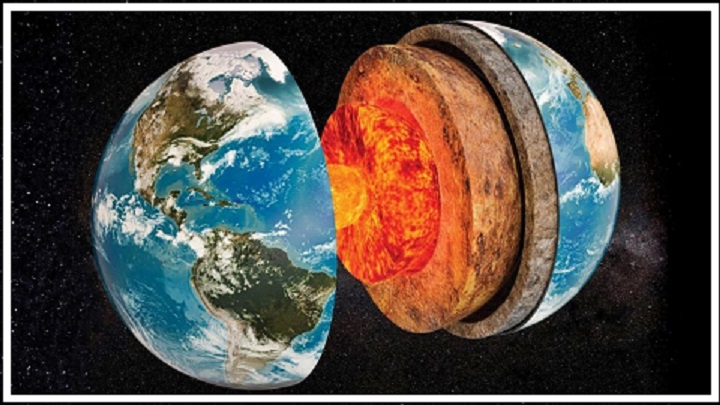What is The Layers of Earth? You’re standing on the surface of a planet that’s far more than just rock and soil. Beneath your feet lies a living, breathing world—one of flowing rock, rivers of molten metal, and a core hotter than the Sun.
Earth isn’t just a solid ball—it’s a dynamic, layered masterpiece, each level playing a crucial role in shaping everything from earthquakes to the air we breathe.
As an Earth science lover, I’ve always been fascinated by what lies below. Today, we’re taking a journey through all five major layers of Earth, uncovering their secrets, quirks, and why they matter to you.
Table of Contents
🌎 The Layers of Earth: A Cosmic Onion with a Fiery Heart
Imagine Earth as a giant, multi-layered cake—each slice has its own texture, flavor, and purpose. Scientists study these layers using earthquake waves (nature’s X-rays) and lab experiments that mimic the insane pressures deep underground.

Here’s what we’ll explore:
1️⃣ Crust – Earth’s fragile outer shell (where life thrives)
2️⃣ Upper Mantle – The restless engine behind earthquakes & volcanoes
3️⃣ Lower Mantle – A slow-motion river of superheated rock
4️⃣ Outer Core – A swirling metal ocean that powers our magnetic shield
5️⃣ Inner Core – A white-hot iron ball under insane pressure
Let’s dig in—literally!
1️⃣ The Crust: Earth’s Paper-Thin Skin
(Thickness: 5–70 km | State: Solid | Made of: Oxygen, Silicon, Aluminum)
🔹 Fun Fact: If Earth were an apple, the crust would be thinner than the peel!
This is where all life exists—mountains, oceans, cities, and even your backyard. But not all crust is the same:
✔ Continental Crust (20–70 km thick) – Made of granite, it’s light and floats high, forming continents.
✔ Oceanic Crust (5–10 km thick) – Made of dense basalt, it sinks lower, creating ocean floors.
Why It Matters: The crust isn’t one solid piece—it’s broken into tectonic plates that drift like bumper cars, causing earthquakes and building mountains.
💡 Bonus Fact: The deepest human-made hole (Kola Superdeep Borehole) only reached 12 km—just 0.2% of the way to the mantle!

2️⃣ Upper Mantle: The Restless Dance Floor of Earth
(Depth: 35–660 km | State: Solid but with a sneaky “soft” layer)
🔹 Did You Know? This layer has a secret sauce that keeps Earth’s surface moving—the asthenosphere.
It’s divided into two key zones:
✔ Lithospheric Mantle – Rigid and stuck to the crust, forming tectonic plates.
✔ Asthenosphere – A gooey, semi-molten layer that lets plates slide like butter on a hot pan.
🌋 Real-World Impact:
- When parts of this layer melt, they create volcanoes.
- When stress builds up, the crust snaps—earthquakes!

3️⃣ Lower Mantle: The Slow-Motion Blob
(Depth: 660–2,900 km | State: Solid but flows like warm tar)
🔥 Temperatures here reach 3,700°C—hot enough to melt steel, but pressure keeps it solid.
This layer doesn’t just sit still—it circulates heat from the core upward, like a giant underground conveyor belt.
🌍 Why It Matters:
- Powers volcanic hotspots (like Yellowstone).
- Moves about 1 inch per year—slow but mighty.

4️⃣ Outer Core: Earth’s Liquid Metal Dynamo
(Depth: 2,900–5,150 km | State: Liquid | Made of: Molten Iron & Nickel)
🌌 This is where the magic happens.
The churning metal here generates Earth’s magnetic field, which:
✔ Shields us from deadly solar radiation
✔ Guides birds and compasses
✔ Keeps our atmosphere from being stripped away
🔥 Temperature? 4,000–6,000°C—as hot as the Sun’s surface!

5️⃣ Inner Core: The Fiery Iron Heart
(Depth: 5,150–6,371 km | State: Solid Iron | Temp: ~6,000°C)
At Earth’s very center lies a paradox—a ball of iron as hot as the Sun, yet solid due to crushing pressure (3.6 million times stronger than the surface).
🔍 Crazy Facts About the Inner Core:
- It spins slightly faster than the rest of Earth.
- It’s growing by about 1 mm per year as the planet cools.
- It may have iron “mountains” taller than Everest!

🌋 Why Understanding Earth’s Layers Matters
This isn’t just science—it affects your life. These layers:
✔ Trigger earthquakes & volcanoes (which we can better predict by studying them)
✔ Create Earth’s magnetic shield (protecting satellites and power grids)
✔ Shape continents & oceans (determining where we live and what resources we have)
🚀 Final Thought: Earth Is Alive Beneath Us
Next time you walk outside, remember—you’re standing on just the skin of a planet with a fiery, churning interior. From drifting tectonic plates to the Sun-hot core, Earth’s layers work together like a living machine. Earth isn’t just where we live—it’s a wonder we’re still discovering from the inside out. Understanding the Earth science layers of Earth helps us not only appreciate our planet but also predict disasters, find resources, and protect our technology.

So here’s a question for you:
If you could visit one layer of Earth, which would it be?
(I’d pick the outer core—a glowing ocean of liquid metal? Yes, please!)
📢 Loved this journey? Share it! Let’s make Earth science as exciting as it truly is.
